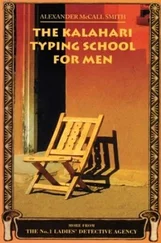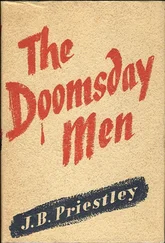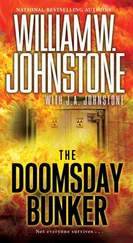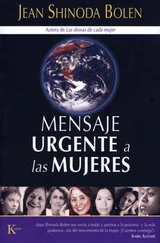3
The Plutonium Collector
The process of decay was forestalled by the powers of the light-ray, the flesh in which he walked disintegrated, annihilated, dissolved in vacant mist, and there within it was the finely turned skeleton of his own hand… and for the first time in his life he understood that he would die.
Thomas Mann,
The Magic Mountain (1924)
A few months after Leo Szilard unveiled his vision of the doomsday bomb, the FBI raided a house in the suburbs of Denver and arrested a 28-year-old research scientist. The astonished neighbours watched as the quiet, bespectacled man was led in handcuffs across the toy-littered lawn of the house where he lived with his wife and three children. Next day the G-men announced to the press that Sanford Lawrence Simons had been charged with the theft of plutonium.
Sanford Simons was working at the University of Denver on top-secret studies of the upper atmosphere for the United States Air Force. During the war he had been employed on the Manhattan Project at Los Alamos, New Mexico, where the atomic bombs were built. In 1946 he had removed from the weapons laboratory a glass vial containing plutonium, the new artificial radioactive element that was at the heart of the Nagasaki atomic bomb. After a brief search, the FBI found the plutonium, still in its original glass vial, hidden beneath his rented home. FBI agent Russell Kramer refused to say how much Simons had taken or what it was worth, but when pressed by journalists, he said that he’d heard figures ranging from $500 to $200,000. In the drawer of a dresser in the Simons’ house, the G-men also found several pieces of uranium.
He admitted straight out that he’d taken the radioactive material. But Simons, who had trained as a metallurgical engineer, claimed it was just a ‘souvenir’ of his time at Los Alamos, which he left in July 1946. Flanked by two impassive US Marshals sporting Humphrey Bogart fedoras, Simons talked freely with the journalists after he had been committed for trial. Unshaven and handcuffed, though still clutching his pipe, Simons seemed remarkably unfazed by his predicament. Under the Atomic Energy Act he faced a possible maximum sentence of five years in prison and a $10,000 fine. Just a few weeks earlier, the FBI had arrested Ethel and Julius Rosenberg in New York on suspicion of atomic espionage. They were both convicted the following year. Despite pleas for clemency from around the world, including from Einstein, the couple were subsequently executed in the electric chair.
‘Why did I take it?’ said Simons sheepishly, in answer to reporters’ questions. ‘Well, it seems pretty silly now, but I’ve always collected mineral samples. I realized almost instantly that I didn’t want it, but it was like having a bull by the tail. I couldn’t let go!’
One of the newspapermen asked how he managed to smuggle the plutonium out of the top-secret military research laboratory.
Simons grinned: ‘I just walked out with it.’ He explained that the plutonium sample had been lying around on his desk for some time. No one had asked for it back, and eventually he simply couldn’t resist it. ‘There was no real check-up on what was taken out of the place at that time,’ he added with a shrug.
You wouldn’t have guessed it from what Simons said, but in the 1940s fissile elements such as plutonium and uranium-235 were more precious than gold to the atomic bomb project. They were the result of a vast expenditure of money and effort. Whole cities of workers laboured to produce these lethal elements in vast industrial complexes built specifically for the Manhattan Project. Each gram was the product of thousands of working hours. It was not unusual to see scientists down on their hands and knees, sweeping the floor with Geiger counters, hunting for any stray pieces of metal that might have been dropped. Sometimes the Geiger counter would crackle furiously as it passed over a tiny orange or black speck on someone’s lab coat, revealing the telltale signs of radioactivity. Even the smallest particle of fissionable matter was extremely valuable, and lab coats were routinely treated with chemicals to reclaim these elements.
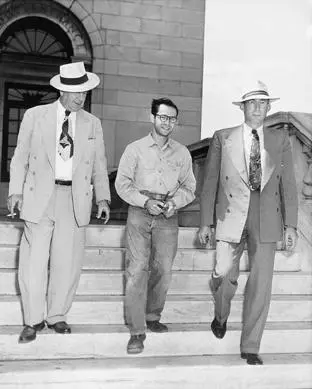
Research scientist Sanford Lawrence Simons – the ‘plutonium collector’ – in the custody of two US Marshals in Denver, August 1950.
Sanford Simons hid the stolen plutonium under his house. He had good reason to. Plutonium has been called the most dangerous element on earth. The glass vial and its deadly contents remained in its hiding place for four years. The FBI became aware of its presence there only after they were tipped off. Simons had let slip in conversation with a friend that he had some plutonium. In the year that Joe McCarthy stoked fears about a Communist fifth column infiltrating American society, to admit that you had a key ingredient for the atomic bomb stashed in your home was simply asking for trouble.
Outside the courtroom, a reporter put it to Agent Kramer that taking plutonium as a ‘souvenir’ was a rather corny excuse. The FBI man nodded in agreement and said, without a trace of humour, ‘He’s a pretty corny guy.’
During his trial the defence pointed out that Simons had never been in trouble with the police. More importantly, he was not a ‘Red’ and had no ‘Communist connections’. The defence attorney based his case on the popular image of the scientist. He argued, somewhat unconvincingly, that scientists are ‘all darned fools’ when it came to experiments. He claimed that scientific curiosity alone had prompted Sanford Simons to take the samples of plutonium and uranium in 1946. It was a case of the irresistible allure of forbidden knowledge, Your Honour, and, as everyone knew, no scientist worth his slide-rule could resist that. But Judge Lee Knous was not particularly impressed by this argument. For taking a pinch of plutonium, the disgraced scientist was sentenced to eighteen months in a Federal prison. 1
The ‘plutonium collector’, as the press dubbed the unfortunate Simons, was driven by a dangerous fascination for the deadly element. Its discovery at the beginning of 1941 marked the point where science could claim to have exceeded the dreams of the alchemists. Plutonium was first identified by chemist Glenn Seaborg, who bombarded uranium with deuterons (the nuclei of heavy hydrogen atoms) and painstakingly separated out the resulting transmuted elements. He recalled that the critical chemical identification took place on the ‘stormy night’ of 23 February 1941, in Room 307, Gilman Hall at the University of California, Berkeley. Twenty-five years later the room was dedicated as a National Historic Landmark. The 28-year-old son of Swedish immigrants to the United States was a dynamic and ambitious scientist, the only person to have an element named after him during his lifetime – element 106, seaborgium.
An alchemist would probably have felt quite at home in Seaborg’s laboratory. It was usually dense with fumes and steam from the processes used to isolate the microscopic amounts of this new matter. By March, he and his co-worker Joseph W. Kennedy had managed to isolate half a microgram of the new artificial element. Talking about this and his subsequent work identifying other new elements heavier than uranium, Seaborg commented:
When you are working with invisible amounts of a new substance, the task of identification is immensely difficult. In one instance, we had only five atoms and a few hours to make a positive identification through chemical analysis. The difficulty can be understood when one realizes that the ink in the dot of an ‘i’ on this page you are reading contains something on the order of a billion atoms. 2
Читать дальше





